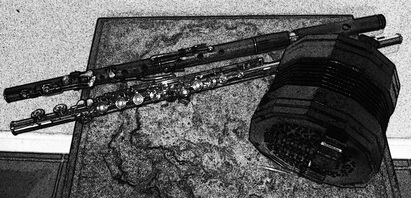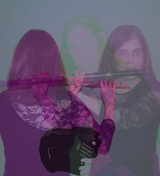Last Thursday was my recital for the Degree Foundation Music course, never been from my mind since I started the course. Despite only taking up silver flute in November, I really wanted to play all three of my instruments in the performance, and was lucky to find a fantastic Boehm flute teacher in February to help me with technique. Having had such fun playing baroque music in the string group, the casual suggestion from my college tutor that I could play a Handel sonata (“grown up music”!) really captured my imagination. From March, not a day went by when I wasn’t playing Handel’s Sonata in F major - as well as hearing it in my mind in the middle of the night, on the bus... everywhere.
The Sonata in F major was one of eleven sonatas written by Handel in the mid-1720’s, often referred to as Opus 1 Number 11, or HWV369. The collection was first published by Walsh in about 1730, although the published manuscripts did not always designate the original instrument that Handel had composed for.
Sonata XI was published “fur Blockflote und Basso continuo”. Blockflote, also known as flauta, indicated a recorder. The Boehm flute was not invented until the latter half of the nineteenth century, and while there were baroque flutes during Handel’s time, these were referred to as querflote or traversos. Of course, playing Handel on a Boehm flute is no more authentic than playing Holst on a Rudall and Rose flute... but it sure is fun.
Handel’s recorder sonatas, according to David Bryson,“were the product of his association with first the Earl of Burlington, whose interest in the arts was genuine, and later with the Duke of Chandos who was a bit of a poseur and opportunist.” All of the sonatas have four movements, based on the “sonata da chiesa” (church sonata) format. The sonatas are not church music, however, but were intended to be "tafelmusik" (played for feasts or banquets) or informal music, played by a family or group of friends. Interestingly, Handel reused much of Sonata XI in the later Organ Concerto V.
The Sonata in F has been frequently recorded by both recorder and flute players. I learned this work from Bärenreiter’s urtext edition, but also looked at other versions on imslp.com. It is astonishing how different the versions are, particularly in phrasing, articulation and metronome markings. I also listened to a variety of recordings, both recorder and flute. Some recordings are completely bare of ornamentation, while others were almost diametrically opposed across the movements in tempo. I really enjoyed Marion Verbruggen’s recording (probably the baroque stylistically correct) and Laurel Zucker’s flowing flute rendition. It is believed that Handel intended for ornamentation to be added to his sonatas, both in the slower movements that are played only once, and certainly in the repeated sections of the allegro movements. In the end, I listened widely and distilled my phrasing and ornamentation to best express the piece for myself.
I also played a set my Rudall and Rose flute, of a gaelic air and two jigs, plus an unknown slow reel on the concertina, that may be a Norwegian wedding march. Laurie Crump accompanied the wooden flute set, and the Handel Sonata, on harpsichord which was lovely, and provided a great balance for the flutes. He also put together a gorgeous piano accompaniment for the concertina set. The programme went well, and was well-received, as were my programme notes:
Sonata XI was published “fur Blockflote und Basso continuo”. Blockflote, also known as flauta, indicated a recorder. The Boehm flute was not invented until the latter half of the nineteenth century, and while there were baroque flutes during Handel’s time, these were referred to as querflote or traversos. Of course, playing Handel on a Boehm flute is no more authentic than playing Holst on a Rudall and Rose flute... but it sure is fun.
Handel’s recorder sonatas, according to David Bryson,“were the product of his association with first the Earl of Burlington, whose interest in the arts was genuine, and later with the Duke of Chandos who was a bit of a poseur and opportunist.” All of the sonatas have four movements, based on the “sonata da chiesa” (church sonata) format. The sonatas are not church music, however, but were intended to be "tafelmusik" (played for feasts or banquets) or informal music, played by a family or group of friends. Interestingly, Handel reused much of Sonata XI in the later Organ Concerto V.
The Sonata in F has been frequently recorded by both recorder and flute players. I learned this work from Bärenreiter’s urtext edition, but also looked at other versions on imslp.com. It is astonishing how different the versions are, particularly in phrasing, articulation and metronome markings. I also listened to a variety of recordings, both recorder and flute. Some recordings are completely bare of ornamentation, while others were almost diametrically opposed across the movements in tempo. I really enjoyed Marion Verbruggen’s recording (probably the baroque stylistically correct) and Laurel Zucker’s flowing flute rendition. It is believed that Handel intended for ornamentation to be added to his sonatas, both in the slower movements that are played only once, and certainly in the repeated sections of the allegro movements. In the end, I listened widely and distilled my phrasing and ornamentation to best express the piece for myself.
I also played a set my Rudall and Rose flute, of a gaelic air and two jigs, plus an unknown slow reel on the concertina, that may be a Norwegian wedding march. Laurie Crump accompanied the wooden flute set, and the Handel Sonata, on harpsichord which was lovely, and provided a great balance for the flutes. He also put together a gorgeous piano accompaniment for the concertina set. The programme went well, and was well-received, as were my programme notes:
| DFM Recital Programme Notes |
On the whole, I was pleased with the way I played, and despite my nerves, managed to breathe my way through the whole programme. Nerves do affect breathing and flute tone, however, and I wish I could have relaxed more to let the flutes sing out as they do when I’m practicing at home. Conversely, playing the concertina, I was so focussed that it seemed as if I was in a bubble with all the time in the world , and it was possibly my best ever concertina playing. The concertina can be an unpredictable instrument to perform on (or perhaps I just haven’t played it for long enough). Forty eight buttons to find with six fingers and no line of sight - in my last warmup before the performance, I was shocked by how many wrong notes it’s possible to play! The pianist Stephen Hough’s recent tweet comes to mind: "Sometimes adrenaline powers the hands; sometimes it sours the stomach." After weeks of worry, some sleepless nights, and hours of practice, the adrenaline helped my focus on the concertina and my fingers on the flutes, but I don’t think it helps relax the flutes’ tone - I need to work on that.
I recorded the entire programme on my phone - have a listen to the Handel Sonata below:
I recorded the entire programme on my phone - have a listen to the Handel Sonata below:


 RSS Feed
RSS Feed